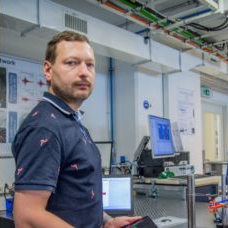Novel Dynamic Measurement Methods and Systems
A special issue of Metrology (ISSN 2673-8244).
Deadline for manuscript submissions: 30 June 2024 | Viewed by 3230

Special Issue Editors
Interests: structural health monitoring; machinery fault diagnosis; finite element modelling; uncertainty quantification of manufacturing processes and dynamic systems; reliability analysis and robust design optimization; smart structures and sensing technologies including full non-contact methods
Special Issues, Collections and Topics in MDPI journals
2.Laboratory of Heating, Ventilation, Air-Conditioning and Refrigeration, Cracow University of Technology, 31-155 Kraków, Poland
Interests: computational fluid dynamics; finite element modelling; flow measurements; sensing technologies for fluid and gas systems; environmental engineering; energy consumption; contaminant distribution in the air; air quality measurements; cooling and ventilation systems design; HVAC systems; cryogenics
Special Issue Information
Dear Colleagues,
An array of measuring instruments can be used to make dynamic measurements of quantities with time-dependent values. Quantities with rapidly changing values, such as vibrations, torque, pressure, force, or flow, are typical examples.
A number of metrology areas now require dynamic measurements instead of the traditional steady-state or static characterisations of a sensor’s performance that were used in the past. Measurement and calibration methods, as well as methods for evaluating uncertainty and correcting sensor outputs, may be required to meet these challenges.
The main, current topics of investigation include:
• New or improved sensors;
• Non-contact measurement methods;
• Dynamic calibration and shock testing;
• Methods for improving the quality of the results;
• Methods for acquiring information and conecton with finite element models (spectrum analysis, parametrical identification, and modal analysis);
• Special application areas, such as vibrations and vibro-acoustics, biomechanics of human movement, full-scale monitoring of civil structures, aerodynamics and wind tunnel testing, fluid dynamics, and image-based measurements.
This Special Issue aims to review the mathematical theory, signal processing, and elements of metrology. In addition, special attention will be paid to novel measurement systems, especially non-contact ones.
Areas of interest include, but are not limited to:
• Sound and vibration measurements;
• Seismic measurements;
• Gas and fluid dynamic measurements;
• Three-dimensional optical sensors and devices (e.g., 3D laser vibrometry, particle image velocimetry, high-speed cameras);
• Data acquisition and signal processing;
• Artificial-intelligence-assisted techniques;
• Analysis of dynamic measuring errors;
• Diagnostics of the machines;
• Computational methods for dynamic measurements;
• Modelling and identification of dynamical systems;
• Dynamics of machinery and rotating systems;
• Transport systems, vehicles, and measuring problems;
• Structural dynamics and vibrations of composite material structures;
• Dynamic measurement problems in environmental engineering;
• Flow and flow-induced vibrations, and fluid–structure interactions;
• Dynamic behaviour of isolation elements and systems.
Both review papers and in-depth research papers on new developments in this field will be collected in this Special Issue.
Dr. Lukasz Scislo
Dr. Nina Szczepanik-Scislo
Prof. Dr. Serge Demidenko
Guest Editors
Manuscript Submission Information
Manuscripts should be submitted online at www.mdpi.com by registering and logging in to this website. Once you are registered, click here to go to the submission form. Manuscripts can be submitted until the deadline. All submissions that pass pre-check are peer-reviewed. Accepted papers will be published continuously in the journal (as soon as accepted) and will be listed together on the special issue website. Research articles, review articles as well as short communications are invited. For planned papers, a title and short abstract (about 100 words) can be sent to the Editorial Office for announcement on this website.
Submitted manuscripts should not have been published previously, nor be under consideration for publication elsewhere (except conference proceedings papers). All manuscripts are thoroughly refereed through a single-blind peer-review process. A guide for authors and other relevant information for submission of manuscripts is available on the Instructions for Authors page. Metrology is an international peer-reviewed open access quarterly journal published by MDPI.
Please visit the Instructions for Authors page before submitting a manuscript. The Article Processing Charge (APC) for publication in this open access journal is 1000 CHF (Swiss Francs). Submitted papers should be well formatted and use good English. Authors may use MDPI's English editing service prior to publication or during author revisions.
Keywords
- dynamic measurements
- transfer function
- vibration measurement
- condition monitoring
- finite element modelling
- structural health monitoring
- modal analysis
- FFT
- dynamic calibration
- flow measurements





